Dakgaejang (Spicy Korean Chicken Soup)
Dakgaejang (Spicy Korean Chicken Soup) is a deeply flavorful Korean comfort soup with shredded chicken, leeks, and chili oil in a rich red broth. Light yet bold, it’s the kind of soup that warms you from the inside out.
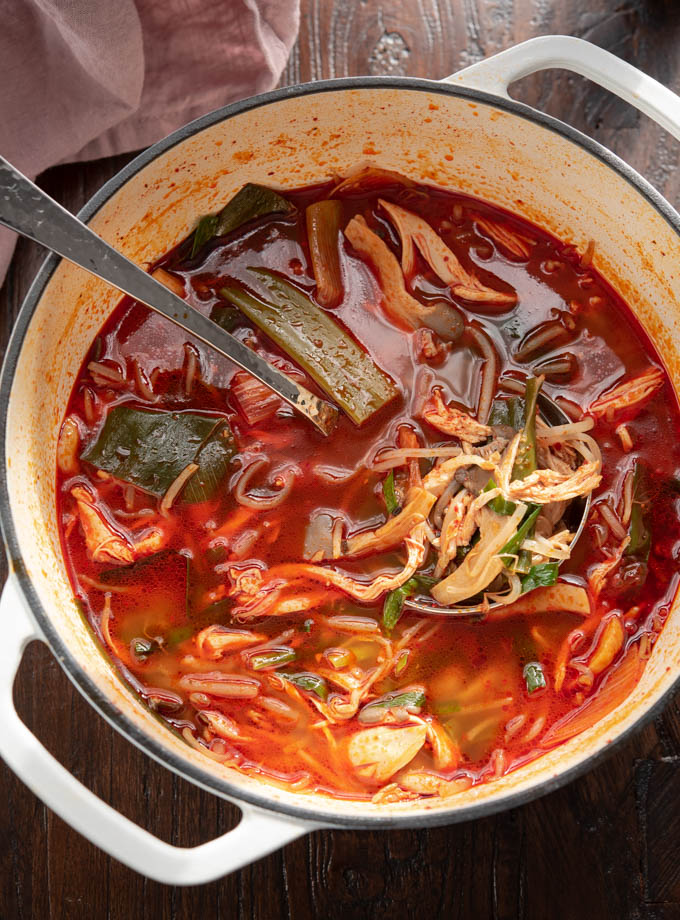
When the cold wind sweeps through, I find myself craving a bowl of dakgaejang — a spicy Korean chicken soup that chases away the chill. My mother often made it on gray, chilly days when someone in the family needed comfort food that healed both body and spirit.
Dakgaejang reminds me of yukgaejang , its beefy cousin, but this version feels lighter and cleaner, with shredded chicken, leeks, and mung bean sprouts soaking in a flavorful red broth. The deep red color of the broth might look fiery, but the spice is gentle and pleasantly warming.
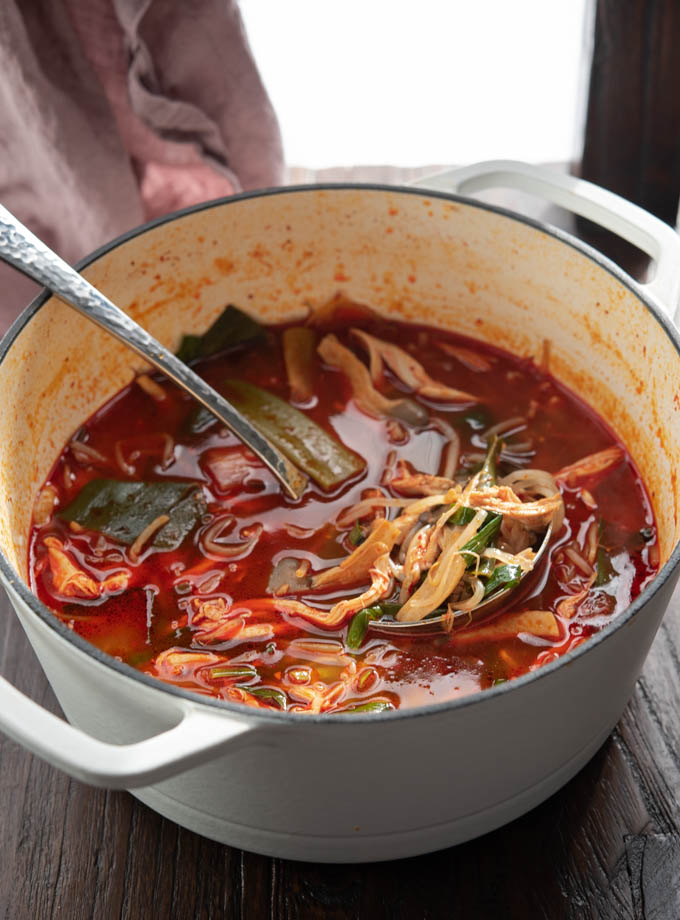
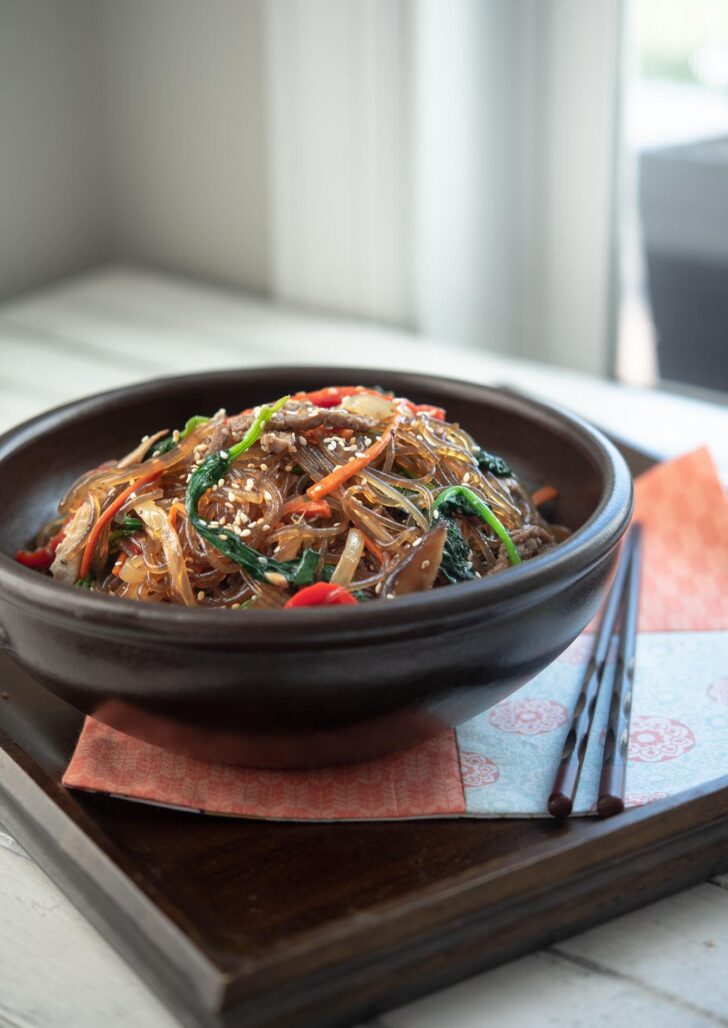
Get new recipes via email:
My Secret to a Deeply Flavorful Dakgaejang
This isn’t just another version of spicy chicken soup — it’s one I’ve fine-tuned to bring out the best flavor and color in every bowl. I start with a light, homemade chicken stock as the base, then build layers of spice and aroma with my own chili oil.
Along with gochugaru, I stir in a small spoon of gochujang (Korean chili paste). It deepens the flavor and keeps the vivid red hue bright to the end — a tiny addition that makes a big difference without changing the authentic taste Koreans love.
I actually use a similar technique in my doenjang jjigae (soybean paste stew) recipe to add richness without heaviness. It’s one of those small details that come from years of home cooking and testing.
If you love soups that are both comforting and bold, this one feels just like something a Korean mom would make on a quiet weekend — deeply flavorful, made with care, and full of warmth. Once you try it, you’ll see why it’s one of my most loved recipes for the cold season.
For another comforting Korean chicken dish, don’t miss dakdoritang—spicy chicken stew with carrots and potatoes.
Build the Base with Homemade Chicken Stock
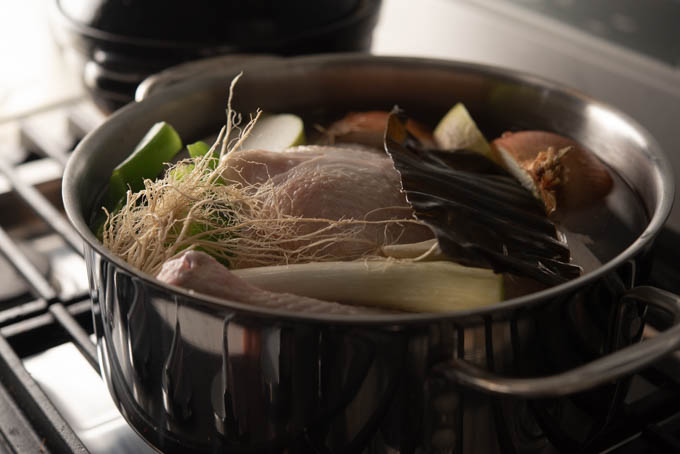
In Korean soups like dakgaejang, everything begins with a clean, flavorful broth. I always make mine from scratch using a whole chicken—it gives the soup a natural richness without turning the broth heavy or greasy. You’ll taste the difference in each spoonful.
To make the stock, combine the chicken with onion, leek, garlic, and a few slices of Korean radish. I also like to add a small piece of dried kelp (dashima) for that subtle depth of umami you find in traditional Korean broths. Let it simmer gently until the meat is tender and the broth turns slightly milky.
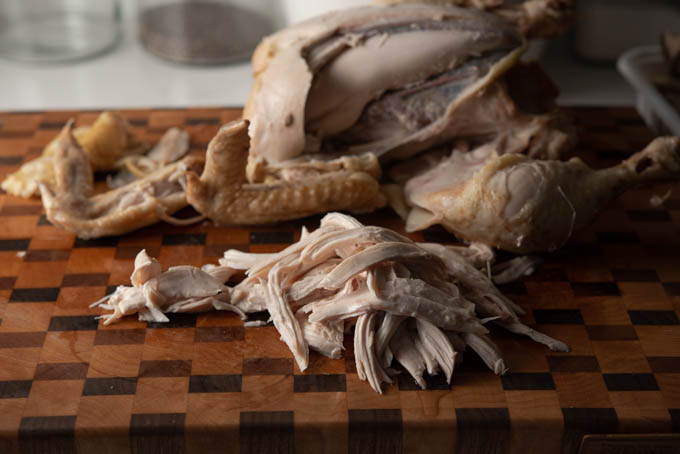
Once cooked, remove the chicken and shred it into bite-size pieces for later. Strain and keep the broth clear—you now have a beautiful base that carries the spice and aroma of dakgaejang perfectly.
If you already have homemade chicken stock on hand, you can use that too. But for the most authentic flavor, a fresh batch made this way always delivers the best result.
Bring It All Together: How to Make Dakgaejang
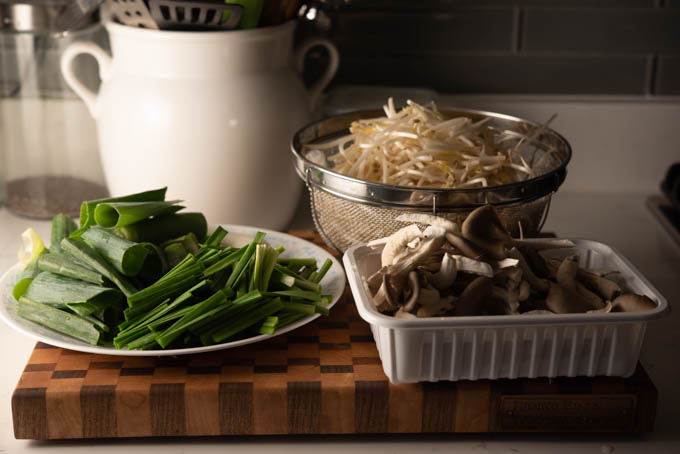
Once your homemade stock is ready, it’s time to build layers of flavor and bring everything together into one comforting bowl of soup. Prepare the vegetables — mung bean sprouts, Asian leek, Asian chives, and oyster mushrooms.
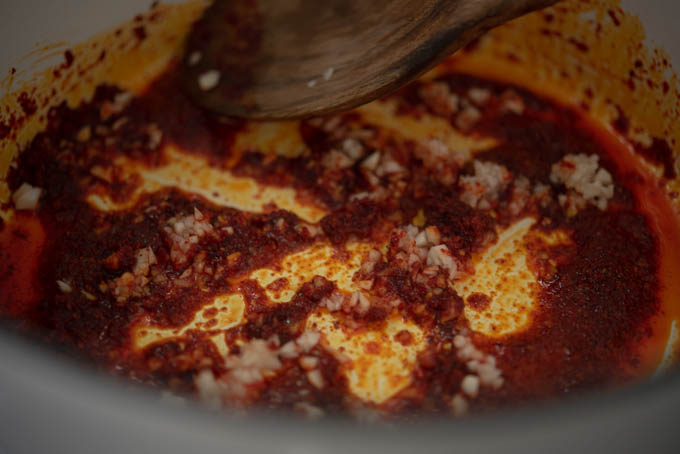
Make the Chili Oil Base. Start by slowly heating oil with gochugaru and minced garlic. Keep the heat low. You want the chili flakes to release their color, not burn. The oil should turn a deep red within a minute or two. This step creates the foundation of the soup’s signature flavor and color.
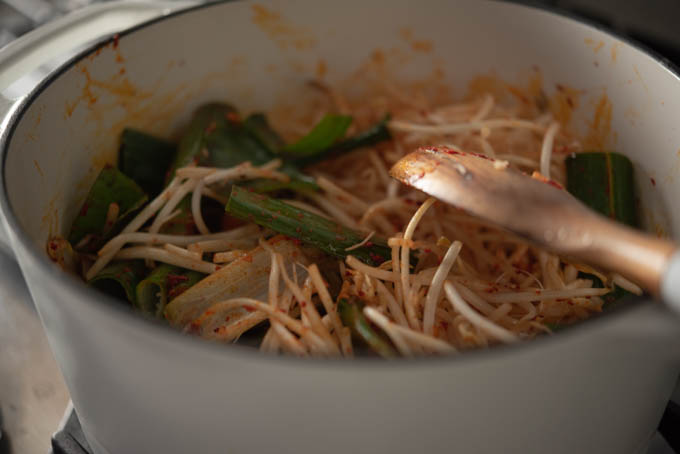
Cook the Vegetables. Add your leeks, mung bean sprouts, and mushrooms into the chili oil. Stir them briefly until they start to soften and glisten. This not only seasons the vegetables but also infuses them with a subtle smokiness that builds character in the broth.
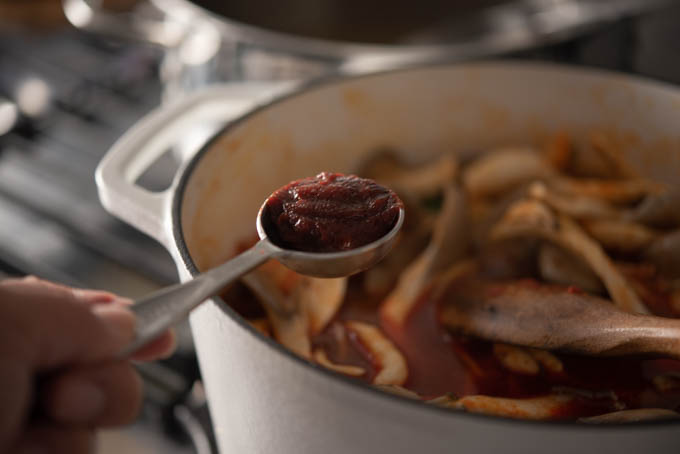
Add the Stock and Gochujang. Pour in your prepared chicken stock and stir in the gochujang.
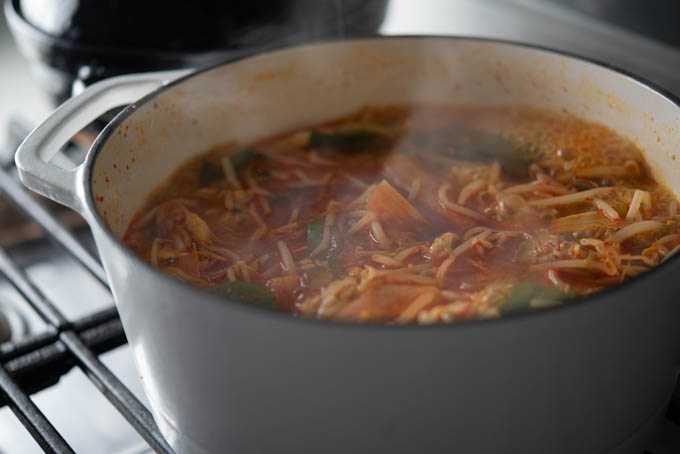
Simmer. Let the soup simmer gently until the vegetables are tender and the flavors come together.
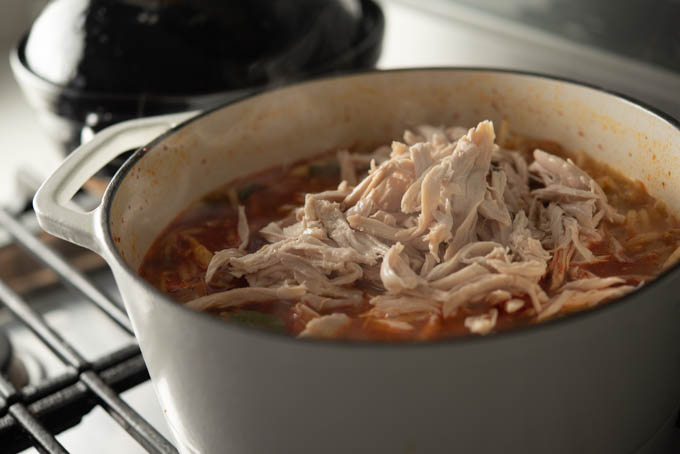
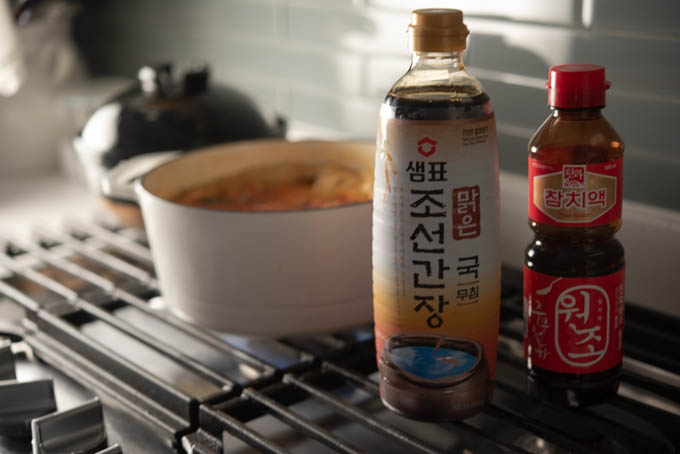
Add the Chicken and Seasonings. Add the shredded chicken to the pot. Season with Korean soup soy sauce and, if you have it, tuna sauce — a small addition that deepens the umami beautifully.
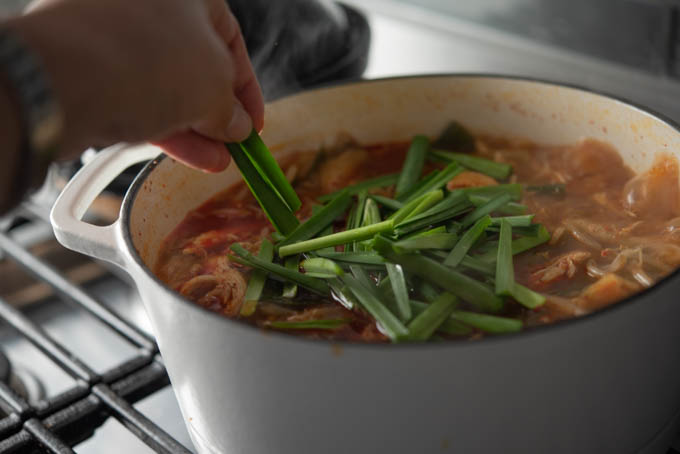
Put Chives at the End. Finish the soup with a handful of Asian chives for a fresh, lightly garlicky aroma. If you can’t find them, simply add a bit more green onion instead. It still brings a nice brightness to the broth.
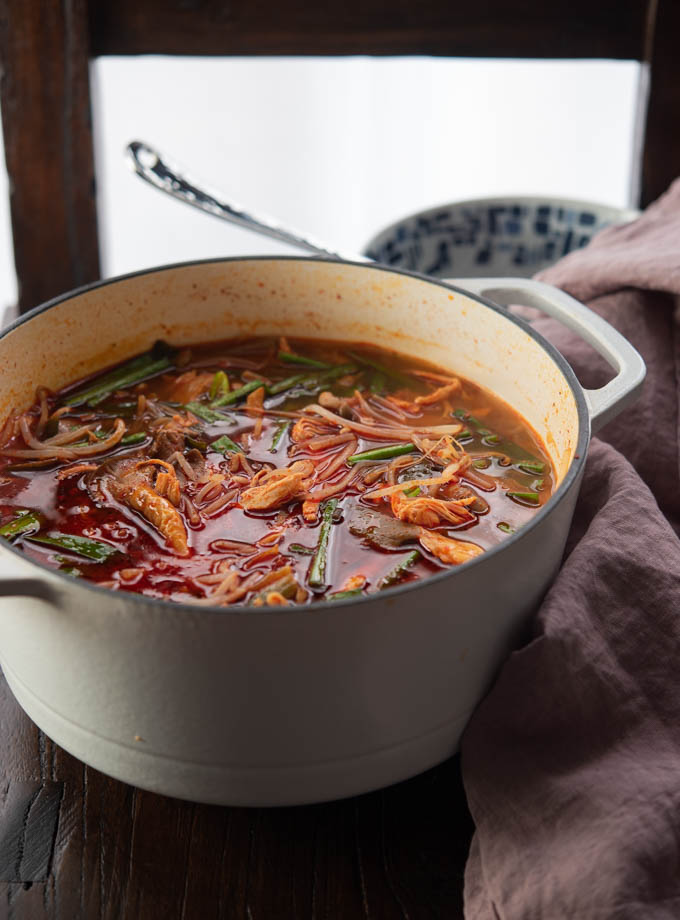
When you ladle the finished soup into a bowl, you’ll see why this dish stands out — a vibrant red broth, tender chicken, and vegetables that soak up every drop of flavor. It’s simple cooking, but done with intention — the kind that fills the kitchen with warmth.
Serving and Storage Tips
I love serving dakgaejang with a bowl of warm rice and a side of kimchi — that’s all you really need. The broth has enough body and spice to stand on its own, and the rice helps mellow the heat.
This soup keeps beautifully. Store leftovers in the fridge for up to a week — the flavors deepen with time, so it often tastes even better the next day. You can also freeze it for up to 3 months; just cool it completely and pack it in airtight portions. Reheat gently on the stove to bring the flavors back to life.
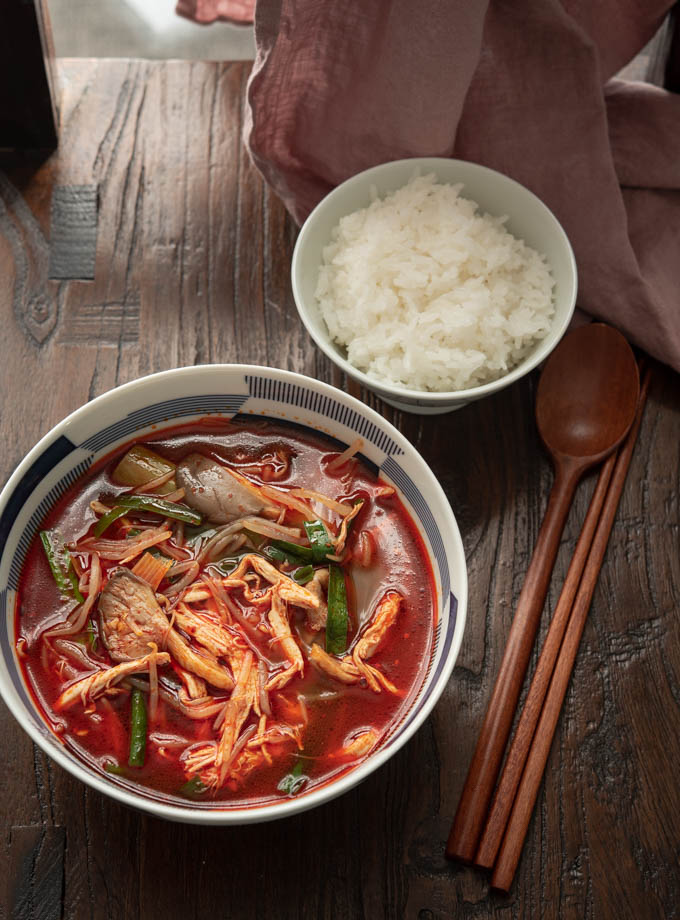
Love this recipe? Rate it and share your experience in the comments below! On Instagram? Tag me to showcase your creation. For more delicious recipes, subscribe to our newsletter!
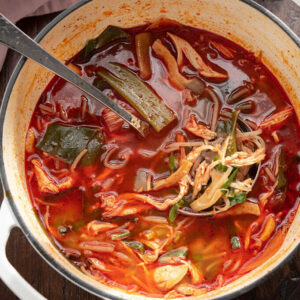
Dakgaejang (Spicy Korean Chicken Soup)
Ingredients
For chicken stock
- 1 2.5-3 lb (1.1–1.4 kg) whole chicken
- 2-3 thick slices of Korean or daikon radish
- 1 onion, cut in half
- 1 Asian leek, sliced, see note below
- 6-7 cloves garlic
- 1 dried sea kelp (dashima)
- 12 cups (2.8–3 liters) water
For chili oil
- 2 tbsp (30 ml) oil
- 1 tbsp (15 ml) sesame oil
- 2-3 tbsp (14–21 g) Korean chili flakes (gochugaru)
- 3 cloves (about 9 g) garlic, finely minced
For soup
- 10 oz (280 g) mung bean sprouts
- 1 (about 80 g) Asian leek, sliced, or a bunch green onion
- 5 oz (140 g) oyster mushrooms, or other mushrooms
- 1/2-1 tbsp (8–15 g) Korean chili paste (gochujang)
- 2 tbsp (30 ml) Korean soup soy sauce (gukganjang)
- 1 tbsp (15 ml) Korean tuna sauce, optional
- 1/2 cup (about 30 g) Asian chives, sliced, optional (See note below)
- salt and pepper to taste
Instructions
- To make the chicken stock: Add all the stock ingredients in a stock pot and pour water. Bring to a gentle boil, then simmer for 45 minutes over low heat. Transfer the chicken on the side, discard the vegetables and reserve the stock. Shred chicken and set aside.
- To make the chili oil: Heat oils in a large soup pot over low flame, add the chili flakes and garlic. Cook until oil turns red and fragrant, stirring constantly; about 1 minute. Be careful not to burn the chili flakes.
- To make the soup, Add the leeks and mung bean sprouts to chili oil in a pot, stir-fry for 2-3 minutes until softened. Add the mushrooms and toss. Pour the reserved stock.
- Add the chili paste and mix everything well. Bring the soup to boil over medium heat and cook until the vegetables are soft and tender.
- Add the shredded chicken and heat through. Season the soup with Korean soup soy sauce and the tuna sauce (if using). Add the Asian chives (if using) and stir well. Add more sauces, and salt & pepper according to your taste. Serve hot with rice and kimchi on the side.

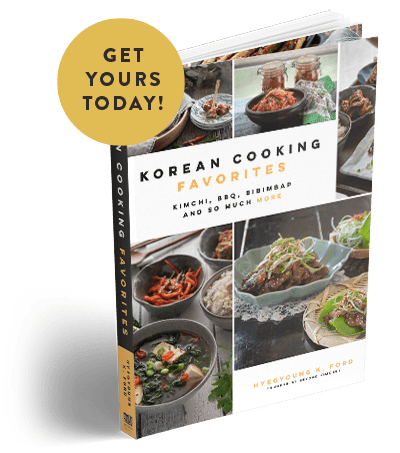
My husband was stationed in Korea and this recipe takes us back there. I make it for us a few times a month. I do add a jar of spicy kimchi to it and that gives it another layer of deliciousness. Thank you so much, it is such a treat.
Thank you for this recipe, it is delicious! I froze half, and whenever I have a cold, I defrost and heat it up and it always makes me feel better 🙂
So glad to hear that this soup made you feel better. Korean chicken soup, does bring a good comfort to those who enjoys a spicy food. Thank you for your comment!
Hi!
I’m going to try this amazing sounding recipe but have a question about the chili oil. In ingredients list there is no mention of garlic but in the instructions for making the chilli oil you mention adding chili flakes and garlic.
What’s the ”proper” way to do it- with or without garlic? As a garlic fan I might add it anyways but just checking!
Hi Allisa
Thanks for pointing out the garlic. The garlic should be added when you make the chili oil. Somehow the garlic was missing in the ingredient list. I corrected the recipe card. Hope you like this soup.
Made this tonight, with dark meat turkey because that’s what I had, and the soup is fantastic! Great flavor and it makes enough for plenty of leftovers!
Hi Elizabeth
Turkey sounds like a wonderful substitution. Glad to hear you liked this soup. Thanks.
This looks terrific! I LOVE spicy soups, and this is so perfect for today’s weather. Thanks!
So appetizing and warming! Perfect for the freezing cold weather we have over here.